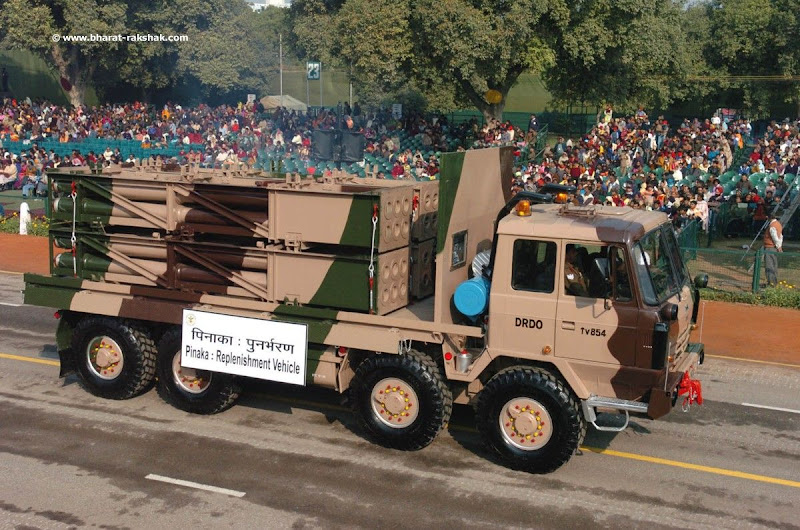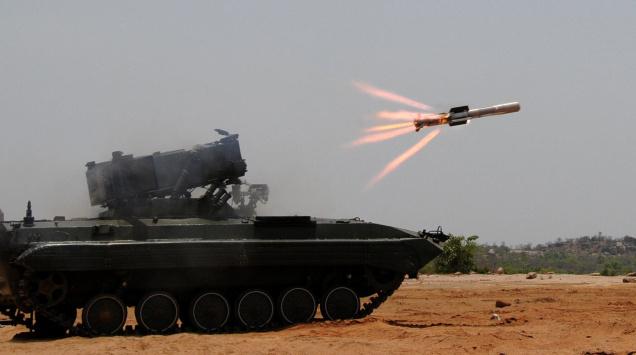Top 10 Most Powerful Indian Weapons
India is one of the most rapidly growing militaries in the world. They have evolved from a regional force with tactical capabilities to a growing strategic force with global reach. They are heavily dependent on foreign suppliers for equipment as their local industry hasn’t quite delivered as promised. But the ones in service are top quality indigenous systems. This article will cover the 10 most powerful weapon systems used by the Indian Armed Forces. It is interesting to note that even though most of the weapons in the list are foreign supplied, the Indians have modified many of them to suit their requirements. They are known for purchasing well known platforms and integrating them with sub systems from around the world to create a lethal system which would turn out better than the original. This makes them a force to reckon with. The order of weapons in the article is entirely based on my analysis and opinion. I haven’t included strategic nuclear weapons and their delivery platforms. After over a hundred fan requests in the past month, Defencyclopedia brings you this article. So sit back and enjoy reading it.
-
Pinaka MLRS


-
PAD/ AAD Ballistic Missile Defense (BMD) System
-
NaMiCa (Nag Missile Carrier)

This is a relatively unknown weapon that is developed by India. The core of this system is the 3rd generation Nag Anti-Tank missile mounted on a modified BMP-2 chassis. It contains 8 Nag missiles in armored box launchers plus a further 8 for reload with a complete optical and IR sensor suite to detect enemy tanks. These missiles are fire and forget and have a top-attack capability which allows them to target the vulnerable top part of the tanks. The Nag has a tandem High Explosive Anti-Tank (HEAT) warhead which enables it to penetrate any armour in the region. It has successfully detected targets at 5 km and engaged them in day and night conditions and has demonstrated its ability to destroy enemy tanks. The most unique ability of this system is its amphibious capability, which allows it to be cross any water body in the battlefield.
This weapon system is very unique as very few armies possess similar systems. The Indian Army has placed an initial order for 13 Namicas and 443 Nag missiles. They have projected a requirement for 200 Namicas and 7000 Nag missiles. The Namica will form an integral part of Indian Army armoured formations. It will spearhead tank divisions and eliminate high-priority enemy armoured targets at long ranges. Future variants may incorporate longer ranged Nag missiles.
-
P-8i Neptune
India has a 7500 km long coastline and hundreds of islands which need protection. The water bodies surrounding India are expansive and perfect for hostile submarines to lurk in. That’s where the P-8I comes in. It was chosen for its excellent endurance and sensor suite which is unequalled by any other ASW aircraft. It has a mission endurance of 4 hours at a distance of 2000 km from base. This means that it can fly 2000 km from base, hunt submarines for 4 hours and then fly back 2000 km to base on just its internal fuel. The fact that it is essentially a modified commercial airliner makes its maintenance very easy. The P-8I has a long range search radar in its nose and the Indian variant is unique in having a Magnetic Anomaly Detection (MAD) boom at the aft to hunt submarines. Also, the Indian variant replaces several electronics systems with Indian versions.
It can carry 120 sonobouys internally and 6-8 Mk-54 torpedoes in its bomb bays along with 4 Harpoon missiles under its wings. This allows it to engage a whole range of surface and underwater threats. The P-8I thus gives the Indian Navy the ability to project power in the Indian Ocean and hunt submarines thousands of km away from their coast. India currently operates 8 aircraft with 4 more on order. They have an option to purchase 12 additional aircraft at a later date, which I’m sure they will after retiring their Tu-142s in the next decade.
-
T-90S Bheeshma

Being an operator of over 5000 T-55/72 tanks, it was natural that the Indian Army chose the T-90S as their replacement. They were first procured hurriedly from Russia in response to its neighbor’s attempt to purchase the T-80 and Abrams tanks. It weighs just 48 tons and has a crew of 3 which is made possible by the use of an autoloader for the 125 mm smoothbore gun. The unique feature of this tank is its ability to fire the Invar anti-tank missile from its barrel. The other special feature is that, even though the 12.7 mm machine gun mounted on the turret is manually operated, it can also be remotely controlled from inside the turret by the commander. The Indian variants have indigenous Kanchan ceramic armour which is topped by a layer of Explosive Reactive Armour (ERA). It is powered by a diesel engine which makes maintenance easier and reduces fuel consumption compared to the gas turbines of the T-80.
It is said that the Indian T-90S are downgraded variants of the Russian T-90A, but the Indians have fitted it with Israeli, French and Swedish sub systems and have made it possibly better than the Russian variant itself. It is slated to be fitted with the Saab LEDS-150 Active Protection System (APS) which will give it a 3-layered defense against enemy anti-tank munitions. The first layer is the APS, the second layer is the ERA and the third layer is the Ceramic armour. The T-90S can be easily deployed anywhere as it can be airlifted by Il-76 and C-17 transports of the IAF. India operates around 600 T-90S and the eventual number by 2020 is expected to be around 1500 tanks.
-
INS Vikramaditya
India’s latest aircraft carrier is the largest ship ever operated by them. This 45,000 ton refurbished carrier is currently the most powerful asset in the Indian Ocean. It has the capacity to deploy 24 MiG-29K fighters along with 6 ASW/AEW helicopters. This formidable combination gives the Indian Navy a very useful power projection tool. The carrier has a Russian electronic and sensor suite which is said to be powerful enough to prevent it from being tracked by powerful airborne radar systems. Though currently unarmed, the carrier will receive the Barak-8 SAM for self-defense during its first refit. The carrier uses a ski jump to launch fighters and arrestor wires to recover them, classifying it as a STOBAR carrier.
-
Phalcon AWACS

India was late in entering the Airborne Early Warning and Control System (AWACS) scene, but they did so with a bang, by procuring what is described by the FAS as the most advanced AWACS in the world. It consists of an Israeli Elta EL/W-2090 radar mounted on a Russian Il-76 aircraft. This radar is a 360 ° Active electronically Scanning Array (AESA) which is mounted inside a dome on top of the Il-76. The specialty of the radar is that it is stationary as its beams are electronically steered as well, which eliminates the need for the radar to be steered mechanically. This allows it to track targets 10 times faster when compared to well-known systems like the E-3 Sentry. It has an integrated IFF system, Electronic Counter Measures (ECM) and ECCM suites for self-protection, Electronic Intelligence (ELINT) for collecting data about enemy radars and monitoring communications and SatCom systems.

The 3 Phalcons are an invaluable asset for the Indian Air Force and act as major force multipliers. They can detect targets 500 km away and such a feature can prove to be vital in mountain and desert regions where ground based radars are not widely deployed. They can track up to 100 targets simultaneously and guide fighter jets and SAMs to intercept them. The probability of detecting cruise missiles and repelling surprise enemy air attacks is very high if such a system is employed in combat. They are frequently deployed with fighter escorts and they can be vectored to intercept long range threats. India is planning to procure a further 2-3 such systems.
-
INS Chakra

After acquiring the Akula II class SSN Nerpa from Russia on a ‘lease’ for 10 years, the Indian Navy gained the ability to provide a long range underwater escort for their carriers and destroyers. The INS Chakra is modified for Indian needs and carries a mix of 36 Torpedoes and Klub Anti-ship missiles which can be fired from the 8×533 mm torpedo tubes. There are reports that India will acquire another Akula SSN, the Iribis which is currently under construction. It may be modified to carry vertical launch tubes for BrahMos missiles.
-
BrahMos Missile
-
Su-30Mki

If there is one aircraft that has defined the Indian Air Force in the 21st century, it’s the Su-30Mki. This is a long range, multi-role, supermaneuverable 4.5+ gen fighter which is built according to Indian specifications. The baseline Su-30Mk from Russia was modified with French, Israeli and Indian avionics to create the ultimate Su-30 variant for India. It became the Su-30Mki where ‘i’ stands for India (Indiski). After realizing the combat potential and versatility of this amazing fighter, the IAF placed an order for 314 aircraft which makes India the largest Su-30 operator in the world.
The Su-30Mki is the bread and butter of the IAF as the rest of their fleet consists of legacy 4th gen fighters which have just a fraction of the capabilities of this fighter. With its 4000+ km range, 12 Hardpoints for 8000 kg of weapons, PESA Bars radar, it outclasses any other fighter in the region. It is safe to assume that 1 Su-30Mki can do the job of 2 MiG-29 and 2 Jaguar combined. It is currently used for air defense, reconnaissance and ground attack. The Su-30Mki is evolving into a cruise missile platform for the IAF. By 2016, it will be integrated with BrahMos and Nirbhay cruise missiles which would give it strike capabilities never before imagined by the IAF or its rivals. It also is integrated with several indigenous and imported electronic jamming pods and anti-radiation missiles which make it a deadly platform for Suppression/Destruction of Enemy Air Defense (SEAD/DEAD) which is the most important part of modern warfare to sanitize enemy threats.
